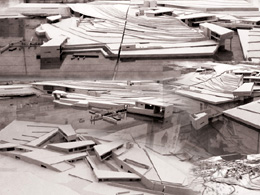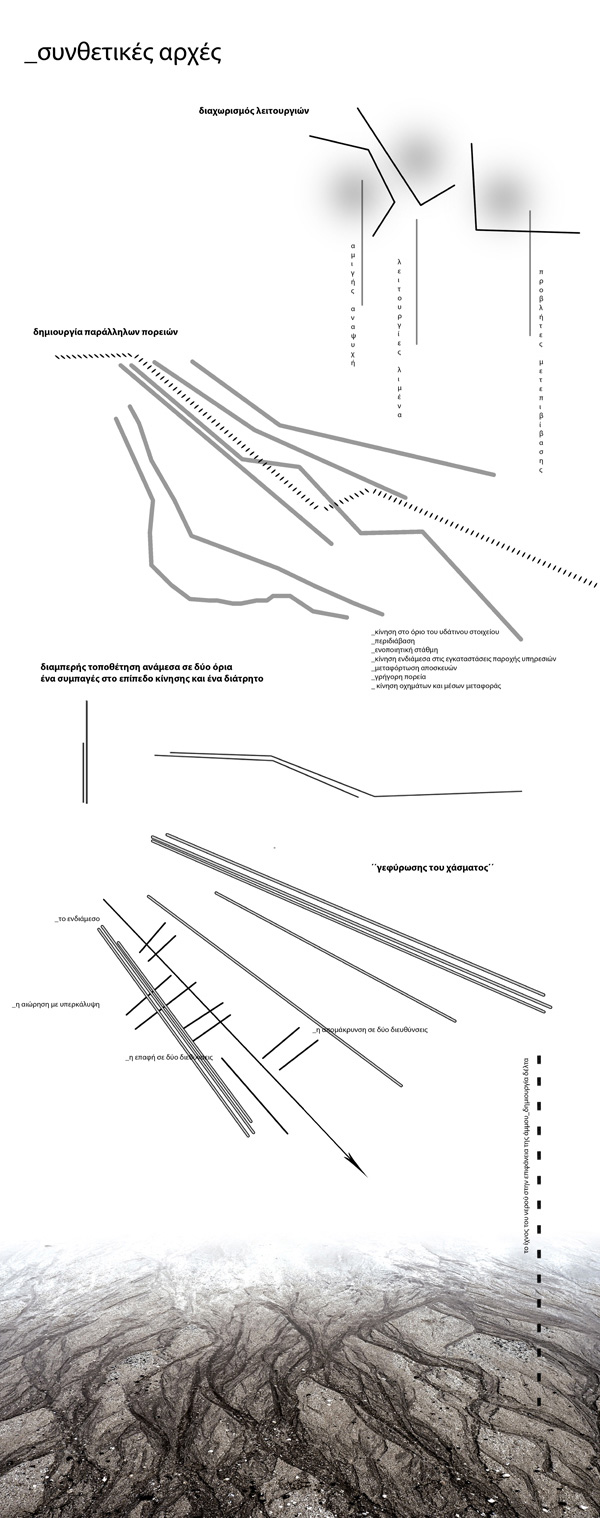STUDENTS PROJECTS
PROJECTS2012

04 April, 2013
Redesign of the north pier at the passengers port of Lavrio
Corrosion, deposition, erosion.
Students: Karafylli Maria, Karafylli Christina
Supervisors: Neli Marda, Moraitis Konstantinos,
Consulter: Karadimas Konstantinos
National Technical University of Athens/ School of Architecture
Date of presentation: Athens, 19 July 2012
The subject of our diploma project concerns the redesign of the north pier at the passengers' port of Lavrio. The purpose of the interference is the creation of a space with social function, in conjunction with the port facilities. The composition constitutes a complex of two functional entities in order to give the untapped area of the port, both local but also supralocal character.
Noting the strategic position of the port, the saturation of passenger ports of Attica and the proximity of Lavrio with the Aegean islands and the international Athens airport, we recognize the necessity for its designation in eastern port gateway, with ultimate purpose the promotion of short sea shipping policy and the development and upgrading of eastern Attica.

The site of our composition is in direct contact with the yet-to-be-constructed terminal of suburban railway, composing a strong scene of interchanges between the airport and the islands of Aegean. The new dock is planned at the limit of the city of Lavrio, directly adjacent to the old warehouses of the French mining company and constitutes the limit of the shoreline. The space is organized in three sections with unifying element the coastline, the terrain and the routes of motion.

Corrosion _the division of the dock
The aquatic element is a powerful configuration item of the coastal line and constitutes at the same time limit and unifying factor between the land and the sea. The endless motion of the calm sea, with the passage of time decomposes the terrain. The mobility of the water acts gently on unabated surfaces, creating a changing landscape, while the trace of the water remains in the coast as momentary reminder of its existence.
Facing the water as a tri-dimensional element, we understand that as long as it remains unaffected presents uniformity, as well as the existing dock. The segmentation, therefore, of the dock both horizontally and vertically, with uplifts and recessions is intended to create different qualities of space between the hard peak and the volatility of the water.
Deposition_ the construction of a hill
During the synthesis process, the question of separating the varied functions was raised, both for the creation of a social space that is not burdened by the operation of the port and the unhindered and independent operation of the second.
The conformation of the landscape has been based on creating a hillside. We propose a new embossed which attaches to the existing unwelcoming platform the third dimension and offers alternative routes and viewpoints to the visitor. This synthetic movement seeks the operation of the site as a memory space, as in the newer mining history of the region hills were formed by the residues of the mining processes (slag).
Our goal is to create a hill which continues the natural terrain of the existing hill and that is a natural extension of the seabed, as well as creates a protected hug for the port facilities.
Erosion _ cracking the hill
The second nature of the sea, in addition to her calm form that we analyzed before, is the one that literary is called boisterous and we could say has the ability to impose on the land its own rules. The effect on the landscape is absolute, causing the erosion.
We perform a split, with the objective to create a natural drop in which we place the port facilities. The crack guides the flow of passengers to a predefined route, similar to that of a river delta. Making consecutive and with advancing range slices on the ground we determine the path of passengers' circulation from the entrance level to the boarding platform. The widening of the layout directs the visitors' eyes towards the water, while the reverse course is framing the ruins of the warehouse of the French mining company.
The cut comes in conjunction with the cave named chaos. The one boarder causes the sensation of vertigo, while the other, the smooth slope, unifies the landscape with the manmade environment. The artificial hill is a unifying factor between the two functions, maintaining at the same time, two different qualities depending on the limit that is in contact with.

Synthetic principles
The synthetic formulation can be expressed in two courses, a spiral and a scattered that cuddle the geometry of the soil and identifies with the leisure course and line organizing the functions of the port.
The helical path is made at the end of the aquatic element constituting a free walkthrough which gradually reveals coastal formations.
The scattered route takes place within the crack and modulates a grid of movements. The main route is branched off into three separate parallel,
_the circulation of means of transport
_rapid access of passengers to the port
_a walk through the port facilities.
During the period of wandering around from entering to the boarding platform, the visitor encounters a sequence of actions interwoven with the historic importance and the nature of the place.
Bridging the crack is carried out by the already raised structural volumes mounted either in the intermediate or floating by superposition, either in contact or moving away from the terrain. The nature interacts with the premise, the full and empty alternate. T0his variety of structural volume transitions is aided by the plethora of secondary buildings, ancillary spaces and movements.

The structural volumes are composed of folds, structed by uncoated concrete. The filling of the facade and the formation of openings constitute the major morphological features. Being in recession, the openings stress the shell. The transmittance of the buildings and the through going facade ensure an unhindered viewing to the wharf. The shade is ensured by the terrain and the premise itself in combination with vertically placed blinds. The view from the city to the wharf's functions is naturally obstructed by the terrain. An attempt is being made to interfere in a humane scale and in keeping with the materiality and the spirit of the place.

The architectural vocabulary is shaped in conjunction with the elements of the site. The stone terracing, buffer construction, the soil, the raging nature, the formations of the water, the tunnels of the ancient mines with the bursts and the concessions, the French ladder, the retaining walls, the harsh architecture of the modern city of Λαυρίου and the two-dimensional nature of the existing platform of the port are the root forces in composition. The analysis and the reinterpretation of the unique characteristics of a separate site with special features was a challenge.











